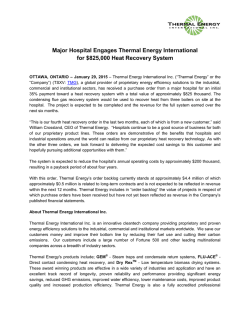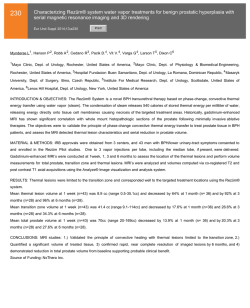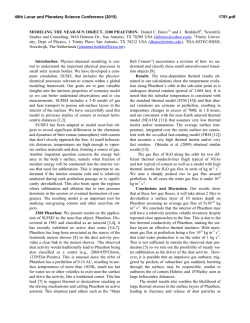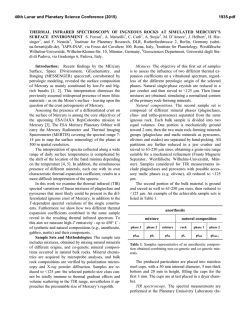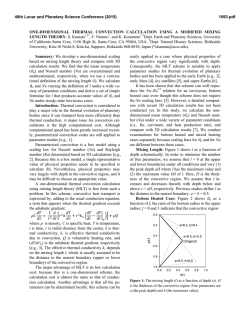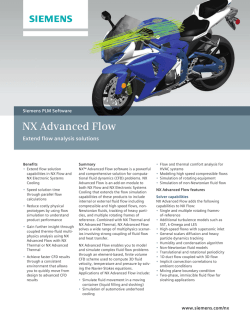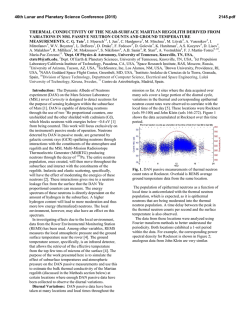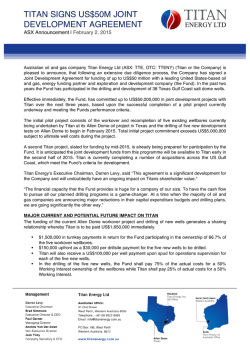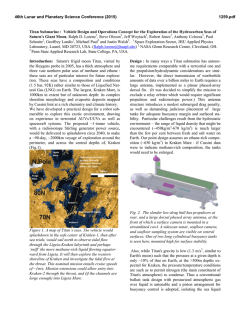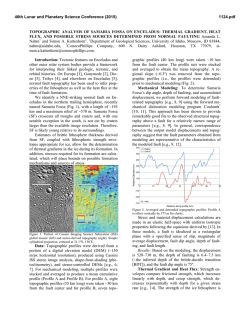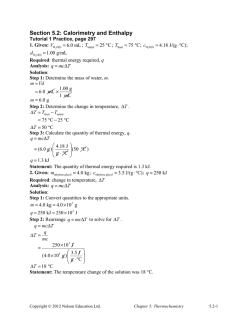
1573
46th Lunar and Planetary Science Conference (2015) 1573.pdf A SIMPLE ONE-DIMENSIONAL RADIATIVE-CONVECTIVE ATMOSPHERE MODEL FOR USE WITH EXTRASOLAR ATMOSPHERES. R. L. Mickol1, H. N. Farris1, E. Kohler1, V. Chevrier1, T. A. Kral1,2 and C. Lacy1,3. 1Arkansas Center for Space and Planetary Sciences, University of Arkansas, Fayetteville, AR, 72701, USA; 2Dept. of Biological Sciences, University of Arkansas, Fayetteville, Arkansas, 72701, USA; 3Dept. of Physics, University of Arkansas, Fayetteville, Arkansas, 72701, USA; [[email protected]]. Introduction: Since the discovery of the first extrasolar planet over 20 years ago [1], there currently exist over 1750 confirmed planets outside our solar system [2]. As technology has advanced over the last few years, it is now possible to determine the major constituents of exoplanet atmospheres [3-5]. To learn more about these planetary systems, an accurate atmospheric model is needed. This project aims to reproduce a radiativeconvective model written by Robinson and Catling (2012) [6]. The model will be transferred from the programming language IDL, to Python, which is freely available, in an effort to make the code easier to use and obtain. In addition, following successful reproduction of the model, we will attempt to model the formation of unusual cloud types in exoplanet atmospheres. This project serves to improve the initial model presented previously [7]. Methods: The radiative-convective model of Robinson and Catling [6] was copied from IDL into Python, accounting for differences in syntax. This model uses ten input parameters (see Table 1) and outputs two variables, τ0 (gray infrared optical depth integrated from top of atmosphere down to p0) and τrc (optical depth at boundary between convective and radiative regions), in a solution [6]. In the radiative region ( 0 ≤ τ ≤ τrc), the temperature, upwelling thermal flux and downwelling thermal flux are given by equations 1, 2, and 3, respectively: (1) where Fi is the internal flux of the planet (Fi,Titan = 0) and D is the diffusivity factor (D = 1.66) [6]. The temperature, upwelling thermal flux and downwelling thermal flux in the convective region ( τrc ≤ τ ≤ τ0), are given by equations 4, 5, and 6, respectively: (4) (5) (6) where β = α(γ - 1)/γ. Table 1. Model Input Parameters [6] Parameter Titan Jupiter 1.5 bar 1.1 bar 94 K 191 K 4/3 2 ratio of specific heats at constant P, V 1.4 1.4 α avg. ratio of true lapse rate (convection region) to dry adiabatic lapse rate 0.77 0.85 F1s absorbed stellar flux in channel 1 1.5 W/m2 1.3 W/m2 F2s absorbed stellar flux in channel 2 1.1 W/m2 7.0 W/m2 k1 ratio of visible optical depth to gray infrared optical depth (Ch. 1) 114 163.6 k2 ratio of visible optical depth to gray infrared optical depth (Ch. 2) 0.2 0.03 reference pressure T0 reference temperature n scaling parameter γ (2) (3) Definition p0 Additionally, working with our initial model [7] reproducing the simple one-dimensional radiative model from Robinson and Catling [6], we have determined additional vapor pressure curves to apply to extrasolar planet atmospheres. Curves for forsterite (Mg2SiO4), 46th Lunar and Planetary Science Conference (2015) sodium sulfide (Na2S), and aluminum oxide (Al2O3) were obtained from Fortney (2005) [8]. Curves for enstatite (MgSiO3) and iron (Fe) were reproduced using the vapor pressure equations from Ackerman and Marley (2001) [9]. However, a correction of 0.5 x 105 was required to produce the accurate curve (verified using Fortney [2005]). Model parameters for exoplanet GJ3470b were obtained from the NASA Exoplanet Archive [2]. Results: Following the example provided by Robinson and Catling, the thermal profile of Titan was successfully reproduced (Fig. 1). Further, using the designated input parameters [6], the thermal profile of Jupiter was also produced (Fig. 2). Vapor pressures of five elements and compounds (Mg2SiO4, Na2S, Al2O3, MgSiO3 and Fe) were graphed against the thermal profile for GJ3470b (Fig. 3). 1573.pdf solar flux, and the convective flux [6]. The model will also be adapted to be used with the NASA Exoplanet Archive in order to model exoplanet atmospheres. Five vapor pressure curves were plotted for the thermal profile of exoplanet GJ3470b using our initial simple radiative atmospheric model [7]. Clouds can potentially form where the compound/element saturation vapor pressure curve intersects the thermal profile of the exoplanet (Fig. 3). Future work will address additional compounds that could be present in exoplanet atmospheres. We will also model additional exoplanets in the attempt to constrain possible cloud types/heights with model parameters. Figure 3. Thermal profile of exoplanet GJ3470b (red, solid curve), using model previously described [7]. Vapor pressure curves (dotted) for various elements and compounds are labeled (obtained from [8, 9]). Figure 1. Thermal profile of Titan. Figure 2. Thermal profile of Jupiter. Discussion/Conclusion: The simple radiativeconvective atmospheric model of Robinson and Catling [6] was successfully reproduced in Python for the examples of Titan (Fig. 1) and Jupiter (Fig. 2). Future work will enhance the model with the addition of the upwelling and downwelling thermal fluxes, the net Acknowledgements: The authors would like to acknowledge T. D. Robinson and D. C. Catling for the availability and usefulness of their code. This research has made use of the NASA Exoplanet Archive, which is operated by Caltech, under contract with NASA under the Exoplanet Exploration Program. References: [1] Wolszczan, A. and Frail, D. A. (1992) Nature, 355, 145-147. [2] NASA and Caltech. NASA Exoplanet Archive. (2014) http://exoplanetarchive.ipac.caltech.edu/. [3] Tinetti, G. et al. (2007) Nature, 448, 169-171. [4] Swain, M. R., Vasisht, G. and Tinetti, G. (2008) Nature, 452, 329-331. [5] Fraine, J. et al. (2014) Nature, 513, 526529. [6] Robinson, T. and Catling, D. (2012) The Astrophys. J., 757, 104 (13pp). [7] Kohler, E., et al. (2014) LPS XLV, Abstract #2290. [8] Fortney, J. J. (2005) Mon. Not. R. Astron. Soc., 364, 649-653. [9] Ackerman, A. S. and Marley, M. S. (2001) The Astrophys. J., 556, 872-884.
© Copyright 2026
